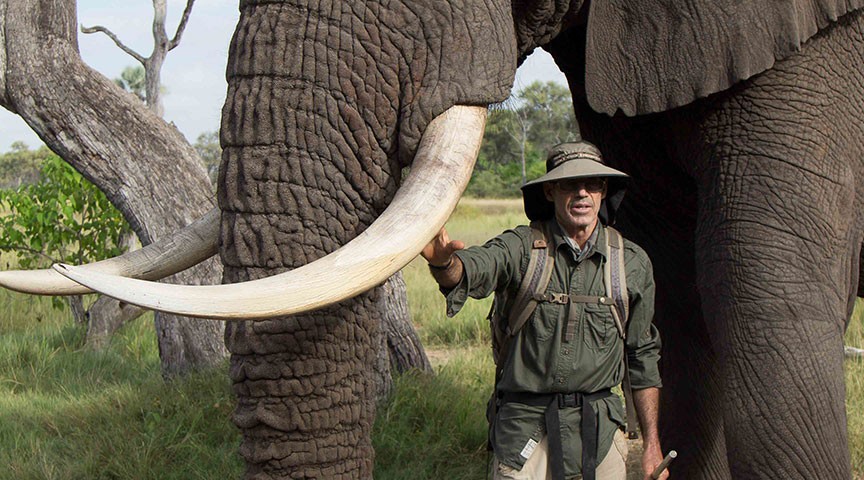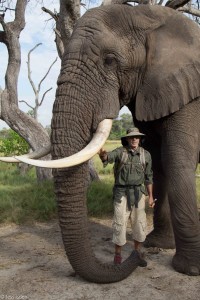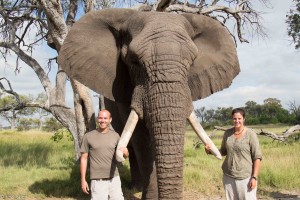
Wrapping up farmers and fields – By James Stevens
June 15, 2015
Travel & Arrival in Camp by Helen Shaw
August 4, 2015Meeting ‘the herd’ by Jess Isden

Doug and Sandi Groves are a remarkable couple who have dedicated their lives to caring for their herd of three African savannah elephants. The herd consists of one male and two female elephants who were all victims of culling
programmes, but now live in the Okavango Delta where they can forage and interact alongside their wild counterparts under the protection and guidance of Doug and Sandi. James and I had the privilege of meeting them all on a recent trip to the Delta.
Culling programmes can have disastrous consequences for young elephants. Without the guidance and authority of older individuals, youngsters can mature with a range of developmental problems which are often linked to exhibiting aggressive and dangerous behaviour. In many cases, young orphans are sold to zoos, game reserves or into private ownership, and can suffer from the lack of expertise and affection usually shown by elders. The three elephants we met were all orphans of culling, and each have their own story to tell. Jabu, the impressive bull elephant, was orphaned at the age of two. Thembi, the smallest female with arguably the biggest personality, was also orphaned at a very young age by a cull in South Africa. Morula was rescued by Doug and Sandi at the relatively old age of 17, having suffered a range of troubling experiences since she had been orphaned by a cull in Kruger National Park. All three are now playing an active role in educating local people and tourists about the plight of savannah elephant, and encouraging us all to view animals as individuals with varying personality traits. Tourists can sign up to visit them as part of a safari experience through Stanley’s Camp, a luxury lodge in the heart of the Delta. One of the most important activities that the elephants have taken part in has been their interaction with local school children. In 1999 Doug and Sandi set up the not-for-profit organisation Living with Elephants to help facilitate a more harmonious relationship between Botswana’s elephant and human populations. Their outreach programme has seen over 200 children per year meet Jabu, Morula and Thembi, learning about conservation through hands-on experience and interaction.
When we venture out with Doug and Sandi early in the morning, Jabu is the first elephant to be introduced. Doug tells us that if he is not first, he gets jealous and irritable! Being able to walk right up to an adult bull elephant, who towers above you is a breath-taking experience. It is also an experience completely alien to us as researchers who work with wild elephants; the golden rules for us are to give each elephant plenty of space, and never leave the safety of our vehicle. Jabu gently sways his trunk back and forth over our shoes as Doug explains about how he is ‘left-trunked’, meaning that he always wraps vegetation anti-clockwise around his trunk and then uses his tusk to tear it away and feed. Standing virtually between his front legs, you gain an idea of just how huge and heavy a male’s trunk is; no wonder they often rest it upon their tusks or drag it along the floor as they walk! His tusks rest at about the level of my shoulders, and as I moved my hand over the surface of his tusks I was amazed at how smooth it felt; years of using them to chisel the bark off of trees has that effect. Likewise, the back of Jabu’s ears felt soft and velvety, and I was able to see each and every notch and hole; traits that we frequently use to help us identify wild individuals in our park.
Next we meet Morula, who today shows little sign of her troubled background. Sandi talks to us about her daily habits; what she eats, how she sleeps against a raised mound and how she vents her frustrations on tree branches. Morula demonstrates a variety of behaviours, seeming to particularly enjoy lying down and being subtly handed fruity treats by Sandi. Thembi is the final elephant to greet us, which she does with an enthusiastic wave of the tip of her trunk. Upon a gentle command from Doug, she opens her mouth wide and shows us her teeth, which are perfectly designed for grinding through tough vegetation. All three of the elephants are trained using operant conditioning, a time-consuming but effective method using rewards, not punishment, to encourage certain behaviours. The elephants do not meet guests every day and after they have left, the herd, which includes Doug and Sandi, are allowed to wander and forage, mud-bathe or swim as they please. At night they are housed in a spacious boma for their own safety; the impressive nature of Jabu’s tusks sadly make him a prime target for poachers. At the end of our visit I was sad to say goodbye to my new herd-mates, but was
waved off enthusiastically by Thembi and with a trumpet from Jabu.
Our own personal experience of meeting ‘the herd’ has left James and I with a new perspective on the animals that we observe every day. To see the individual hairs on Jabu’s trunk, Thembi’s perfectly aligned molars and to touch the base o of Morula’s enormous foot really does encourage us to observe each of our wild elephants as an individual, especially when they are in groups of thirty or more. This understanding will help us when we analyse the social networks of individually identified elephants in the Makgaikgadi. The commitment that Doug and Sandi continue to make, not only to their own herd, but to the wider goal of increased elephant research, education and conservation, is humbling. You can follow ‘the herd’ and find out more about their activities on the Living with Elephants Facebook page.


